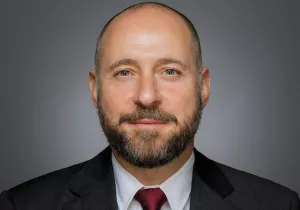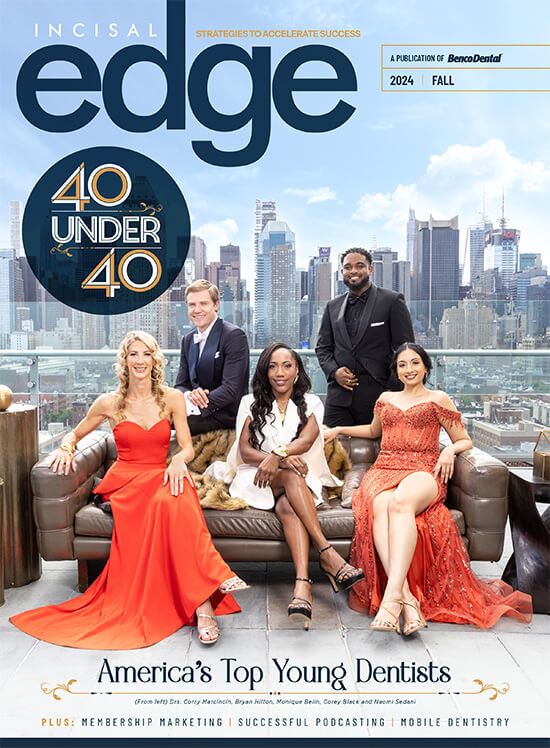In his role overseeing the Herman Ostrow School of Dentistry of the University of Southern California,
Dr. Avishai Sadan is helping to shape the future of our entire profession.
BY ALEXANDRA LEVINE

Now the dean of the Herman Ostrow School of Dentistry of the University of Southern California, Sadan describes his profes-sional trajectory like this: “Accidentally stumbled into dentistry. Not part of the plan. Got in for the wrong reason, stayed for the right reason. Because once I got to know what dentistry is all about, there was no doubt that I’d made the right choice.”
That background — initial indifference followed by abiding passion — infuses everything Dean Sadan (above) has accom-plished over seven years at Ostrow’s helm. “A culture of discov-ery is part of the genetics of USC,” he says. “Inquiry is mandato-ry.” The university, and its dental school in particular, is a place where “borderline science-fiction” research is paramount, not only to prepare students but also to serve the larger community.
Some students and faculty, for example, address congenital defects such as cleft lips and palates in newborns. The dental school, in collaboration with other USC experts and researchers, has also been exploring ways to detect such defects in utero, at the point of formation, and then alter cell signaling to fix the problems before birth.
Much of the school’s emphasis last year was on helping children, a commitment it maintains into 2016. “Our projects come back to the same point of serving the underserved,” Dean Sadan says. “And the focus is mainly children.”
In 1968, USC was among the first schools to pioneer mobile dental clinics: a practice on wheels, essentially. “The whole idea back then was just to be able to arrive physically in places that don’t provide care,” Dean Sadan says. “You take the service to the population that can’t otherwise get to you.”
When the late Dr. Charles Goldstein, a USC faculty member, started the tradition with just one van, he sought mainly to treat the children of migrant farmworkers. The school’s fleet has since evolved and expanded to encompass seven vans; its patient logs now include homeless veterans and other groups in need, though its core purpose, Dean Sadan is at pains to add, remains children.
USC Dental recently received a $3 million donation from the Hutto-Patterson Charitable Foundation to strengthen its existing mobile clinic, which covers the region between Visalia (in the San Joaquin Valley roughly halfway between Los Angeles and San Francisco) and the Mexican border to the south. To that end, this February the school debuted a new, larger vehicle for the fleet. “What makes this van different is that it doesn’t need to be hooked up for power,” the dean says. “The others need to be hooked up, but this self-sustained trailer can work in places where crisis strikes and there’s no electricity.”
Schools, naturally, are a common stop on the vans’ multiday or weeklong excursions; Dean Sadan is adamant about the cor-relation between a child’s health and his or her success in school.
“For some people outside the dental-education environment, it’s hard to realize that a kid who’s in pain is unlikely to succeed, period,” he says. “A kid who’s in pain cannot focus on doing his or her homework and is at a disadvantage moving forward. So instead of coming into a school and saying that we’ll do 5,000 procedures over the course of a week, we’ll take 100 to 200 kids with the greatest needs and provide A-to-Z treatment — pain alleviation being one sliver of that.”
In addition to the money from Hutto-Patterson, the school recently received a grant of $18.4 million from First 5 LA, the group that nearly two decades ago successfully lobbied for a tax to be added to tobacco products, with the money steered toward early-childhood health care, development and education. In 2012, the organization sought grant proposals from dental schools for projects that would benefit the greater Los Angeles area. Under Dean Sadan’s leadership, USC Dental proposed the “CHAMP” initiative: Children’s Health and Maintenance Program.
The grant has allowed USC Dental to pursue a number of projects that benefit local kids. Among them is a new dental facility, operated in conjunction with the Violence Intervention Program for foster children, that helps increase the footprint of USC Dental’s pediatric-dentistry residency and develop a seda-tion program at partner clinics for children.
“Bottom line, our goal was to provide 45,000 disadvantaged children with some access to oral health care within the next five years,” Dean Sadan says. USC Dental received the grant from First 5 LA in late 2012, so it’s now beginning the fourth year of the half-decade program.
“A lot of what we do aims to create some sustainable component to the whole operation,” Dean Sadan adds, “so that the day the grant dries out, we’ll be in a place where we can continue to operate.”
The Ostrow School has come a long way since it opened in 1897 — and a long way as well just since Dean Sadan took the reins in 2009. CHAMP has broadened the school’s reach and impact on the West Coast, and its mobile clinic today represents exceptional progress from its humble beginnings more than four decades ago. Dean Sadan is also excited about how far the school (and the dental industry more broadly) have come with regard to gender equality and minority representation.
USC began accepting female students in the early 1900s, and this year, for the first time since its founding in 1934, the school’s ortho-dontics advanced specialty class is made up entirely of women.
“A culture of discovery is part of the genetics of USC. Inquiry is mandatory.”
USC had no quota or formal goal for an exclusively female class. “It ended up being all women because they were this year’s best applicants,” says the dean of the program’s six students. “It let us pause for a second, reflect and celebrate an accomplishment that was long overdue in professional schools across the board.”
In that regard as well, this year’s commencement speaker for USC Dental will be Carol Gomez Summerhays, an Ostrow alumna (DDS 1978) who has been the president of the American Dental Association since 2015.
The USC Dental class overall is now made up of equal numbers of men and women — all of them inquisitive learners and future clinicians who challenge Dean Sadan every day.
“As I age, the students around me are always going to be the same age, always in their prime,” he says. “So I’m truly kept on my toes, surrounded by these motivated people who have the mindset that they’re going to change the world.” n



